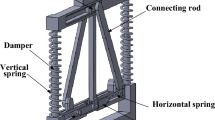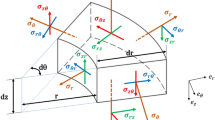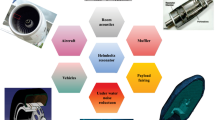Abstract
Hydraulically damped rubber mount (HDM) can effectively attenuate vibrations transmitted between an automotive powertrain and body/chassis and reduce interior noise in the car compartment. Predicting the dynamic characteristics of a HDM faces challenges due to fluid-structure interactions between the rubber spring and fluid in the chambers, nonlinear material properties of the rubber parts and turbulent flow in the chambers and fluid track linking chambers. In this paper, an experimental analysis and hydrostatic finite element (FE) modeling technique are integrated in a numerical simulation approach to modeling the dynamic characteristics of a HDM with a lumped-parameter HDM model. The dynamic characteristics of a typical HDM with a fixed decoupler are predicted and compared with experimental results, which verify the effectiveness of the proposed approach. Moreover, a parametric effect analysis is performed to demonstrate parameter influence on dynamic characteristic, which provides a concise design guideline for the parameter adjustments necessary for a HDM to meet the vibration isolation requirements of a powertrain mount system.
Similar content being viewed by others
References
ABAQUS Theory’s Manual (1998). H. K. S. Incorporation.
Bernuchon, M. (1984). A new generation of engine mounts. SAE Paper No. 840259.
Brach, R. M. and Haddow, A. G. (1993). On the dynamic response of hydraulic engine mounts. SAE Paper No. 931321.
Clark, M. (1985). Hydraulic engine mount isolation. SAE Paper No. 851650.
Colgate, J. E., Chang, C. T., Chiou, Y. C., Liu, W. K. and Keer, L. M. (1995). Modeling of a hydraulic engine mount focusing on response to sinusoidal and composite excitations. J. Sound & Vibration 184,3, 503–528.
Corcoran, P. E. and Ticks, G. H. (1984). Hydraulic engine mount characteristics. SAE Paper No. 840407.
Flower, W. C. (1985). Understanding hydraulic mounts for improved vehicle noise, vibration and ride qualities. SAE Paper No. 850975.
Fox, R. W. and Mcdonald, A. T. (1985). Introduction to Fluid Mechanics. John Wiley & Sons. New York.
Gotz, K., Theodor, G. and Dietmar, G. (1992). Conputerunterstutzte auslegung von hydraulisch gedampften gummilagern. ATZ 94,9, 462–472.
Graf, P. L. and Shoureshi, R. (1988). Modeling and implementation of semi-active hydraulic engine mounts. Trans. ASME, J. Dynamic Systems, Measurement, and Control, 110, 422–429.
Karlheinz, H. (1985). Theorie der gummilager mit hydraulischer dampfung. ATZ 87,10, 545–551.
Kim, G. and Sigh, R. (1993). Nonlinear analysis of automotive hydraulic engine mount. Trans. ASME, J. Dynamic Systems, Measurement, and Control, 115, 482–487.
Kim, H. Y., Bang, W. J. and Kim, J. S. (1992). Large deformation finite element analysis of automotive rubber components by using ABAQUS. ABAQUS Users’ Conf. Proc., Newport, Rhode Island.
Lee, K. H. and Choi, Y. T. (1994). Performance design of hydraulic mount for low frequency engine vibration and noise control. SAE Paper No. 941777.
Lee, K. H. and Choi, Y. T. (1995). Performance analysis of hydraulic engine mount by using bond graph method. SAE Paper No. 951347.
Li, Y. Z. and Fan, M. S. (1998). Fluid Mechanics. High Education Press. Beijing. China.
Morman, K. N. (1998). Recent applications of ABAQUS to the analysis of automotive rubber components. ABAQUS Users’ Conf.
Muller, M. and Siebler, T. W. (1994). Methods for the reduction of noise and vibration in vehicle using an appropriate engine mount system. SAE Paper No. 942414.
Muller, M., Heidrich, M. and Bernhard, U. (1997). Die auslegung von motorlagerungssystemen benchmarking, simulation und versuch. ATZ, 99, 92–99.
Seto, K. and Sawatarl, K. (1991). Optimum design method for hydraulic engine mounts. SAE Paper No. 911055.
Shibayama, T., Takashima, Y. and Horioka, T. (1998). Theoretical investigation of the dynamic characteristic of hydraulic mount. JSAE Paper No. 9833278.
Singh, R., Kim, G. and Ravindra, P. V. (1992). Linear analysis of automotive hydro-mechanical mount with emphasis on decoupler characteristics. J. Sound and Vibration 158,2, 219–243.
Steve, J. G. and Jeffy, D. C. (1995). Experimental study and modelling of hydraulic mount and engine system. SAE Paper No. 951348.
Sugino, M. and Abe, E. (1986). Optimum application for hydroelastic engine mount. SAE Paper No. 861412.
Wang, L. R. (2002). Study of Theory and Methods for Simulation of Nonlinear Characteristics of Hydraulically Damped Rubber Mount. Ph. D. Dissertation. Tsinghua University. Beijing. China.
Wang, L. R. and Lu, Z. H. (2003). Finite element simulation based modeling method for constitutive law of rubber hyperelasticity. Rubber Chemistry Technology, 76, 270–284.
Wang, L. R. and Lu, Z. H. and Hagiwara, I. (2002). Finite element simulation of static characteristics of vehicle rubber mount. Proc. I MECH E Part D, J. Automobile Engineering, 216, 965–973.
Wang, L. R., Wang, J.-C. and Lu, Z. H. and Hagiwara, I. (2007). Finite element based parameter estimations for characteristic simulation model of hydraulically damped rubber mount for vehicle engine. Proc. I MECH Part D, J. Automobile Engineering 221,10, 1273–1286.
Author information
Authors and Affiliations
Corresponding author
Rights and permissions
About this article
Cite this article
Wang, L.R., Lu, Z.H. & Hagiwara, I. Integration of experiment and hydrostatic fluid-structure finite element analysis into dynamic characteristic prediction of a hydraulically damped rubber mount. Int.J Automot. Technol. 11, 245–255 (2010). https://doi.org/10.1007/s12239-010-0031-3
Received:
Revised:
Published:
Issue Date:
DOI: https://doi.org/10.1007/s12239-010-0031-3




